7. Update: The Final, Final Proof!
[ Update: This page added February 2011 ]
 Within the last 18 months or so, at the time of writing, we have seen some wonderful spacecraft images, which have surely killed the idiotic conspiracy theory stone dead, once and for all – at least, in the mind of anyone capable of even the slightest semblance of rational thought! I refer, of course, to the images of the landing sites, returned by NASA’s Lunar Reconnaissance Orbiter probe.
Within the last 18 months or so, at the time of writing, we have seen some wonderful spacecraft images, which have surely killed the idiotic conspiracy theory stone dead, once and for all – at least, in the mind of anyone capable of even the slightest semblance of rational thought! I refer, of course, to the images of the landing sites, returned by NASA’s Lunar Reconnaissance Orbiter probe.
7.1. The Lunar Reconnaissance Orbiter
 NASA’s Lunar Reconnaissance Orbiter ( LRO ) space probe was launched on 18 June 2009. Its purpose, as its name suggests, is to map the surface of the Moon in unprecedented detail, in preparation for future proposed landing missions. It was placed into a very low lunar orbit, at a height of only 50 km; combining that fact with its state of the art cameras, it’s photographing the lunar surface with an incredible resolution of just 50 cm! It’s in a polar orbit – that is, it orbits in a plane perpendicular to the Moon’s equator, passing over its poles – so as the Moon rotates beneath it, it covers the entire surface once per month.
NASA’s Lunar Reconnaissance Orbiter ( LRO ) space probe was launched on 18 June 2009. Its purpose, as its name suggests, is to map the surface of the Moon in unprecedented detail, in preparation for future proposed landing missions. It was placed into a very low lunar orbit, at a height of only 50 km; combining that fact with its state of the art cameras, it’s photographing the lunar surface with an incredible resolution of just 50 cm! It’s in a polar orbit – that is, it orbits in a plane perpendicular to the Moon’s equator, passing over its poles – so as the Moon rotates beneath it, it covers the entire surface once per month.
 It’s hardly surprising, therefore, that NASA decided to direct LRO to photograph the Apollo landing sites as it passed over them, in order to shut up the conspiracy lunatics once and for all! In fact, it has imaged not only all the Apollo landing sites, but also those of the unmanned Surveyor probes, and the Russian Lunas and Lunokhods. In the case of some of the early Luna landers, their precise locations were not even known, as the tracking at the time was only able to identify their landing sites to within a radius of a few kilometres; LRO has pinpointed their exact positions for the first time.
It’s hardly surprising, therefore, that NASA decided to direct LRO to photograph the Apollo landing sites as it passed over them, in order to shut up the conspiracy lunatics once and for all! In fact, it has imaged not only all the Apollo landing sites, but also those of the unmanned Surveyor probes, and the Russian Lunas and Lunokhods. In the case of some of the early Luna landers, their precise locations were not even known, as the tracking at the time was only able to identify their landing sites to within a radius of a few kilometres; LRO has pinpointed their exact positions for the first time.
 There is, of course, plenty of hardware still in place at the Apollo sites, to reveal that men have been there. As explained in Section 2.1, only the upper part, or ascent stage, of each Lunar Module took off and returned to orbit, using the descent stage as a launch platform ( see Fig. 4 in Section 2.1 ) – so each descent stage is still there, exactly where it landed. As explained in Section 3.14, they are far too small to be photographed or identified by any Earth-based telescope, or by the Hubble Space Telescope – but they are easily discernible in the LRO images.
There is, of course, plenty of hardware still in place at the Apollo sites, to reveal that men have been there. As explained in Section 2.1, only the upper part, or ascent stage, of each Lunar Module took off and returned to orbit, using the descent stage as a launch platform ( see Fig. 4 in Section 2.1 ) – so each descent stage is still there, exactly where it landed. As explained in Section 3.14, they are far too small to be photographed or identified by any Earth-based telescope, or by the Hubble Space Telescope – but they are easily discernible in the LRO images.
 Also left behind were the instrument packages which the astronauts deployed on the surface, and the Lunar Roving Vehicles of the last three missions.
Also left behind were the instrument packages which the astronauts deployed on the surface, and the Lunar Roving Vehicles of the last three missions.
7.2. The LRO images of the landing sites
 The images reproduced here are just a few of many, which have been returned from LRO, showing the Apollo landing sites.
The images reproduced here are just a few of many, which have been returned from LRO, showing the Apollo landing sites.
 Let’s start with the obvious one, which everyone would want to see – the historic site of Apollo 11 in Mare Tranquillitatis ( Fig. 12 ).
Let’s start with the obvious one, which everyone would want to see – the historic site of Apollo 11 in Mare Tranquillitatis ( Fig. 12 ).
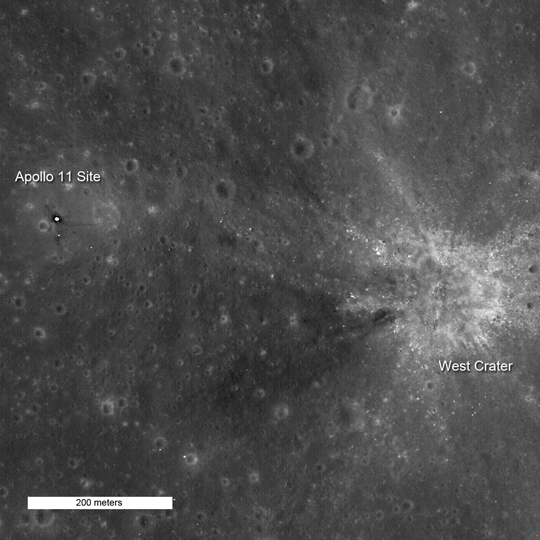
Fig. 12
 That very bright white spot near the left hand edge of the image, just above centre, is the descent stage of the Lunar Module Eagle – LRO was of course looking down on it from above. The smaller white dot, just below it, is the ALSEP ( standing for Apollo Lunar Surface Experiment Package ) – a package of scientific instruments deployed on the surface by Armstrong and Aldrin. ( Every landing mission carried an ALSEP, the experiments within them becoming progressively more complex. )
That very bright white spot near the left hand edge of the image, just above centre, is the descent stage of the Lunar Module Eagle – LRO was of course looking down on it from above. The smaller white dot, just below it, is the ALSEP ( standing for Apollo Lunar Surface Experiment Package ) – a package of scientific instruments deployed on the surface by Armstrong and Aldrin. ( Every landing mission carried an ALSEP, the experiments within them becoming progressively more complex. )
 And those narrow dark lines, extending from the LM, are – wait for it… the trails of the astronauts’ footprints in the surface dust, showing where they walked! Of course, even LRO can’t resolve the individual bootprints, but the trail of disturbed surface material shows up as these lines. This is seen in all of the Apollo site images.
And those narrow dark lines, extending from the LM, are – wait for it… the trails of the astronauts’ footprints in the surface dust, showing where they walked! Of course, even LRO can’t resolve the individual bootprints, but the trail of disturbed surface material shows up as these lines. This is seen in all of the Apollo site images.
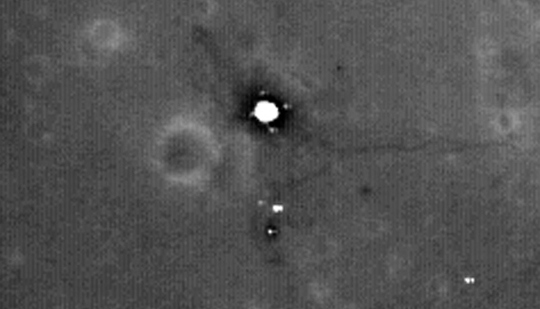
Fig. 13
 Fig. 13 is a closeup of the area around the LM. The LM descent stage – seen from above, remember - now shows as a big white blob, and you can just about make out that its shape is something other than round; its hull is in fact octagonal. But what about those four small white spots, forming a square near its corners? Well, they are its four footpads! See Fig. 4 again; the landing legs are angled outwards from the hull ( obviously, for stability ), so the footpads are visible in the aerial view. Each circular footpad is 86 cm across – so we would indeed expect them to be discernible at the resolution of LRO’s camera. I would challenge any CT to tell me exactly what they think this nicely symmetrical object is, if it isn’t a Lunar Module!
Fig. 13 is a closeup of the area around the LM. The LM descent stage – seen from above, remember - now shows as a big white blob, and you can just about make out that its shape is something other than round; its hull is in fact octagonal. But what about those four small white spots, forming a square near its corners? Well, they are its four footpads! See Fig. 4 again; the landing legs are angled outwards from the hull ( obviously, for stability ), so the footpads are visible in the aerial view. Each circular footpad is 86 cm across – so we would indeed expect them to be discernible at the resolution of LRO’s camera. I would challenge any CT to tell me exactly what they think this nicely symmetrical object is, if it isn’t a Lunar Module!
 Note also that one of the footpads – the one at 8 o’clock – is much fainter than the other three, and barely visible. This is exactly what you would expect; this is the pad whose leg held the ladder, and when the astronauts returned to the LM, the dust from their boots would have fallen onto it!
Note also that one of the footpads – the one at 8 o’clock – is much fainter than the other three, and barely visible. This is exactly what you would expect; this is the pad whose leg held the ladder, and when the astronauts returned to the LM, the dust from their boots would have fallen onto it!
 We also see the trails of the footprints very clearly in this closeup – the “wiggly” nature of the tracks being entirely consistent with their being made by the boots of humans, rather than by anything mechanical.
We also see the trails of the footprints very clearly in this closeup – the “wiggly” nature of the tracks being entirely consistent with their being made by the boots of humans, rather than by anything mechanical.
 Fig. 14 shows the landing site of Apollo 12 in Oceanus Procellarum.
Fig. 14 shows the landing site of Apollo 12 in Oceanus Procellarum.
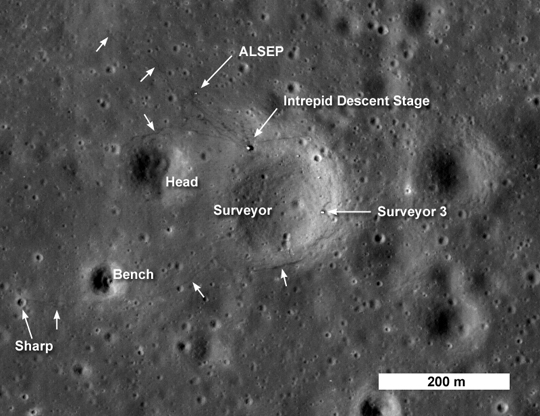
Fig. 14
 Again, we see the descent stage of the LM Intrepid, above centre, on the edge of a small crater, which was named Surveyor Crater. Again, we see the trails of the astronauts’ footprints radiating from it – more of them this time, as Pete Conrad and Alan Bean made two EVAs, as opposed to Armstrong and Aldrin’s single one, and both were longer. And again, we see the ALSEP, as a small white dot to the upper left of the LM.
Again, we see the descent stage of the LM Intrepid, above centre, on the edge of a small crater, which was named Surveyor Crater. Again, we see the trails of the astronauts’ footprints radiating from it – more of them this time, as Pete Conrad and Alan Bean made two EVAs, as opposed to Armstrong and Aldrin’s single one, and both were longer. And again, we see the ALSEP, as a small white dot to the upper left of the LM.
 This time, there is something extra. Look at the other white spot, to the lower right of the LM, on the opposite side of Surveyor Crater. That’s the unmanned probe Surveyor 3, which landed there two and a half years earlier. As described in Section 5.7, Intrepid deliberately landed close to Surveyor 3; Conrad and Bean walked to it during their second EVA, and brought back pieces of it for analysis. Indeed, you can see one trail of footprints leading from the LM to Surveyor 3.
This time, there is something extra. Look at the other white spot, to the lower right of the LM, on the opposite side of Surveyor Crater. That’s the unmanned probe Surveyor 3, which landed there two and a half years earlier. As described in Section 5.7, Intrepid deliberately landed close to Surveyor 3; Conrad and Bean walked to it during their second EVA, and brought back pieces of it for analysis. Indeed, you can see one trail of footprints leading from the LM to Surveyor 3.

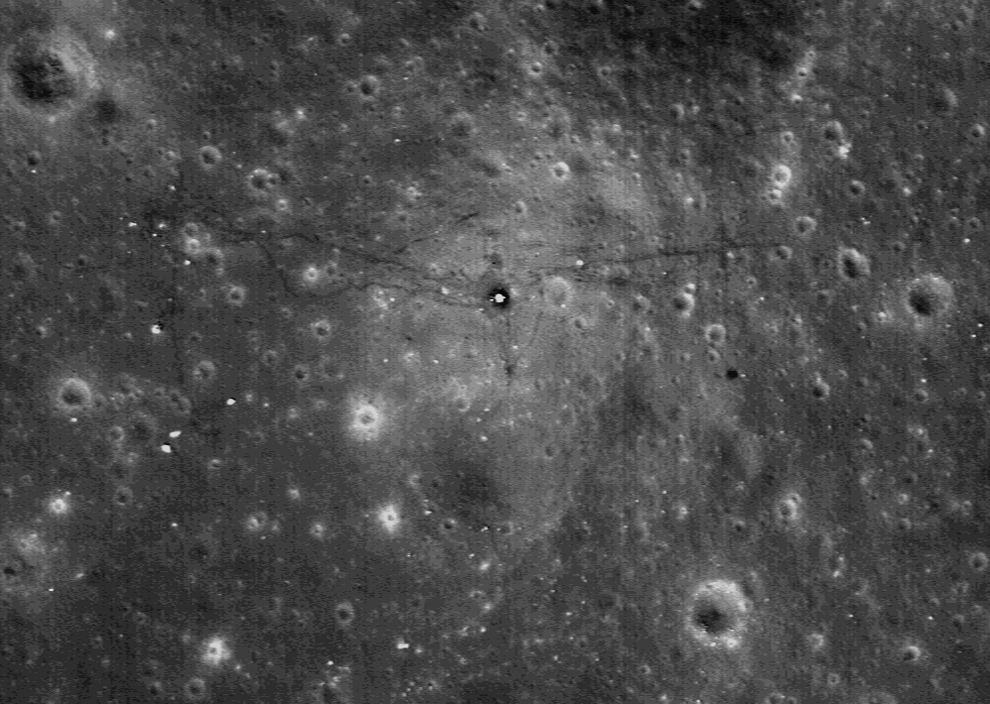
Fig. 15
 Finally, Fig. 15 shows the last landing site, that of Apollo 17, in the Taurus-Littrow region. Once again, we see the descent stage of the LM Challenger, just above centre, with the trails of footprints radiating from it – but we also see something else.
Finally, Fig. 15 shows the last landing site, that of Apollo 17, in the Taurus-Littrow region. Once again, we see the descent stage of the LM Challenger, just above centre, with the trails of footprints radiating from it – but we also see something else.
 Look closely at the tracks. As usual, the prominent, very dark wiggly lines are the trails of disturbed material where the astronauts walked. But there are also several fainter trails, composed of pairs of parallel lines. What could they be?
Look closely at the tracks. As usual, the prominent, very dark wiggly lines are the trails of disturbed material where the astronauts walked. But there are also several fainter trails, composed of pairs of parallel lines. What could they be?
 Well, the last three missions each used a Lunar Rover ( see Fig. 9 in Section 5.2 ). The double tracks are the Rover’s wheel tracks! And the small white spot and dark shadow, at four o’clock from the LM, is the Rover itself, in its final parking spot, a couple of hundred metres from the LM.
Well, the last three missions each used a Lunar Rover ( see Fig. 9 in Section 5.2 ). The double tracks are the Rover’s wheel tracks! And the small white spot and dark shadow, at four o’clock from the LM, is the Rover itself, in its final parking spot, a couple of hundred metres from the LM.
 At this point, I can just hear some rabid CT protesting, “It’s a fake! The Moon car thing would be much heavier than an astronaut, so how can its tracks be so much fainter?” ( Not long ago, I actually read an argument to this effect in a British so-called “newspaper”, written by some dolt who insisted on dredging up the whole conspiracy garbage yet again. ) The answer is obvious, to anyone with any knowledge of elementary physics. While the Rover’s mass was about 750 kg, the area of its four wheels, in contact with the ground, was much larger than that of the soles of an astronaut’s boots, so the pressure which it exerted on the ground – equal to force ( its weight ) divided by area - was significantly less.
At this point, I can just hear some rabid CT protesting, “It’s a fake! The Moon car thing would be much heavier than an astronaut, so how can its tracks be so much fainter?” ( Not long ago, I actually read an argument to this effect in a British so-called “newspaper”, written by some dolt who insisted on dredging up the whole conspiracy garbage yet again. ) The answer is obvious, to anyone with any knowledge of elementary physics. While the Rover’s mass was about 750 kg, the area of its four wheels, in contact with the ground, was much larger than that of the soles of an astronaut’s boots, so the pressure which it exerted on the ground – equal to force ( its weight ) divided by area - was significantly less.
7.3. And for those who are still not convinced…
 Sadly, all of this will still not be enough to convince the most stubborn CT’s! Inevitably, they will just insist that the LRO images of the landing sites have themselves been faked, as a further part of the Great Conspiracy. In fact, even before LRO was launched, some of them were making comments on web sites, to the effect of, “No doubt NASA is going to fake photos of the supposed Apollo landing sites”.
Sadly, all of this will still not be enough to convince the most stubborn CT’s! Inevitably, they will just insist that the LRO images of the landing sites have themselves been faked, as a further part of the Great Conspiracy. In fact, even before LRO was launched, some of them were making comments on web sites, to the effect of, “No doubt NASA is going to fake photos of the supposed Apollo landing sites”.
 Excuse me a moment – head, meet brick wall…
Excuse me a moment – head, meet brick wall…
 So allow me to present one final, final piece of evidence – and then anyone who still clings to the conspiracy drivel is simply beyond hope…
So allow me to present one final, final piece of evidence – and then anyone who still clings to the conspiracy drivel is simply beyond hope…
 LRO is not the only spacecraft currently in orbit around the Moon; there is also a Japanese one, called Kaguya. While its cameras don’t quite match the resolution of those of LRO, its images are still far better than any which preceded it. It’s hardly surprising, that Kaguya has also imaged some of the Apollo sites. Take a look at this pair of images ( Fig. 16 )…
LRO is not the only spacecraft currently in orbit around the Moon; there is also a Japanese one, called Kaguya. While its cameras don’t quite match the resolution of those of LRO, its images are still far better than any which preceded it. It’s hardly surprising, that Kaguya has also imaged some of the Apollo sites. Take a look at this pair of images ( Fig. 16 )…

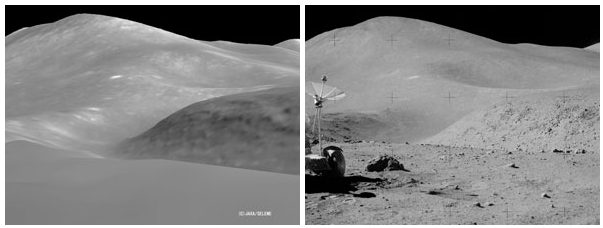
Fig. 16
 These two pictures show an area near the landing site of Apollo 15, in the Hadley Delta region. The flat ground in the foreground is in fact a spot which the Apollo 15 crew visited during one of their EVAs.
These two pictures show an area near the landing site of Apollo 15, in the Hadley Delta region. The flat ground in the foreground is in fact a spot which the Apollo 15 crew visited during one of their EVAs.
 The picture on the right was, naturally, taken on the ground by the Apollo 15 astronauts – hence their Lunar Rover in the picture! The one on the left was taken by Kaguya from orbit, looking from an oblique angle. Notice how the shape of those hills looks remarkably similar in both views…
The picture on the right was, naturally, taken on the ground by the Apollo 15 astronauts – hence their Lunar Rover in the picture! The one on the left was taken by Kaguya from orbit, looking from an oblique angle. Notice how the shape of those hills looks remarkably similar in both views…
 Obviously, they look identical, because they are the very same hills! The Kaguya image shows the exact same spot where Dave Scott and Jim Irwin stood in 1971!
Obviously, they look identical, because they are the very same hills! The Kaguya image shows the exact same spot where Dave Scott and Jim Irwin stood in 1971!
 So I challenge any remaining CT loony to tell me this; if, as you claim, the Apollo photo above was faked in a studio on Earth, then how come it precisely matches the one taken by another spacecraft, operated by another nation, nearly 40 years later? Well????
So I challenge any remaining CT loony to tell me this; if, as you claim, the Apollo photo above was faked in a studio on Earth, then how come it precisely matches the one taken by another spacecraft, operated by another nation, nearly 40 years later? Well????
 Unless, of course, they believe that the Japanese space agency, and all its highly respected scientists and engineers, are also “in on it”, and that NASA bribed them to fake images to support the Great Scam. Refer again to Section 6.3; just how big does a conspiracy have to be, before it becomes impossible?
Unless, of course, they believe that the Japanese space agency, and all its highly respected scientists and engineers, are also “in on it”, and that NASA bribed them to fake images to support the Great Scam. Refer again to Section 6.3; just how big does a conspiracy have to be, before it becomes impossible?
 My thanks to Peter Rea, for bringing the images in Fig. 16 to my attention.
My thanks to Peter Rea, for bringing the images in Fig. 16 to my attention.
Previous page






 Next page
Next page
Return to Contents
 Within the last 18 months or so, at the time of writing, we have seen some wonderful spacecraft images, which have surely killed the idiotic conspiracy theory stone dead, once and for all – at least, in the mind of anyone capable of even the slightest semblance of rational thought! I refer, of course, to the images of the landing sites, returned by NASA’s Lunar Reconnaissance Orbiter probe.
Within the last 18 months or so, at the time of writing, we have seen some wonderful spacecraft images, which have surely killed the idiotic conspiracy theory stone dead, once and for all – at least, in the mind of anyone capable of even the slightest semblance of rational thought! I refer, of course, to the images of the landing sites, returned by NASA’s Lunar Reconnaissance Orbiter probe.
 NASA’s Lunar Reconnaissance Orbiter ( LRO ) space probe was launched on 18 June 2009. Its purpose, as its name suggests, is to map the surface of the Moon in unprecedented detail, in preparation for future proposed landing missions. It was placed into a very low lunar orbit, at a height of only 50 km; combining that fact with its state of the art cameras, it’s photographing the lunar surface with an incredible resolution of just 50 cm! It’s in a polar orbit – that is, it orbits in a plane perpendicular to the Moon’s equator, passing over its poles – so as the Moon rotates beneath it, it covers the entire surface once per month.
NASA’s Lunar Reconnaissance Orbiter ( LRO ) space probe was launched on 18 June 2009. Its purpose, as its name suggests, is to map the surface of the Moon in unprecedented detail, in preparation for future proposed landing missions. It was placed into a very low lunar orbit, at a height of only 50 km; combining that fact with its state of the art cameras, it’s photographing the lunar surface with an incredible resolution of just 50 cm! It’s in a polar orbit – that is, it orbits in a plane perpendicular to the Moon’s equator, passing over its poles – so as the Moon rotates beneath it, it covers the entire surface once per month.
 It’s hardly surprising, therefore, that NASA decided to direct LRO to photograph the Apollo landing sites as it passed over them, in order to shut up the conspiracy lunatics once and for all! In fact, it has imaged not only all the Apollo landing sites, but also those of the unmanned Surveyor probes, and the Russian Lunas and Lunokhods. In the case of some of the early Luna landers, their precise locations were not even known, as the tracking at the time was only able to identify their landing sites to within a radius of a few kilometres; LRO has pinpointed their exact positions for the first time.
It’s hardly surprising, therefore, that NASA decided to direct LRO to photograph the Apollo landing sites as it passed over them, in order to shut up the conspiracy lunatics once and for all! In fact, it has imaged not only all the Apollo landing sites, but also those of the unmanned Surveyor probes, and the Russian Lunas and Lunokhods. In the case of some of the early Luna landers, their precise locations were not even known, as the tracking at the time was only able to identify their landing sites to within a radius of a few kilometres; LRO has pinpointed their exact positions for the first time.
 There is, of course, plenty of hardware still in place at the Apollo sites, to reveal that men have been there. As explained in Section 2.1, only the upper part, or ascent stage, of each Lunar Module took off and returned to orbit, using the descent stage as a launch platform ( see Fig. 4 in Section 2.1 ) – so each descent stage is still there, exactly where it landed. As explained in Section 3.14, they are far too small to be photographed or identified by any Earth-based telescope, or by the Hubble Space Telescope – but they are easily discernible in the LRO images.
There is, of course, plenty of hardware still in place at the Apollo sites, to reveal that men have been there. As explained in Section 2.1, only the upper part, or ascent stage, of each Lunar Module took off and returned to orbit, using the descent stage as a launch platform ( see Fig. 4 in Section 2.1 ) – so each descent stage is still there, exactly where it landed. As explained in Section 3.14, they are far too small to be photographed or identified by any Earth-based telescope, or by the Hubble Space Telescope – but they are easily discernible in the LRO images.
 Also left behind were the instrument packages which the astronauts deployed on the surface, and the Lunar Roving Vehicles of the last three missions.
Also left behind were the instrument packages which the astronauts deployed on the surface, and the Lunar Roving Vehicles of the last three missions.
 The images reproduced here are just a few of many, which have been returned from LRO, showing the Apollo landing sites.
The images reproduced here are just a few of many, which have been returned from LRO, showing the Apollo landing sites.
 Let’s start with the obvious one, which everyone would want to see – the historic site of Apollo 11 in Mare Tranquillitatis ( Fig. 12 ).
Let’s start with the obvious one, which everyone would want to see – the historic site of Apollo 11 in Mare Tranquillitatis ( Fig. 12 ).




